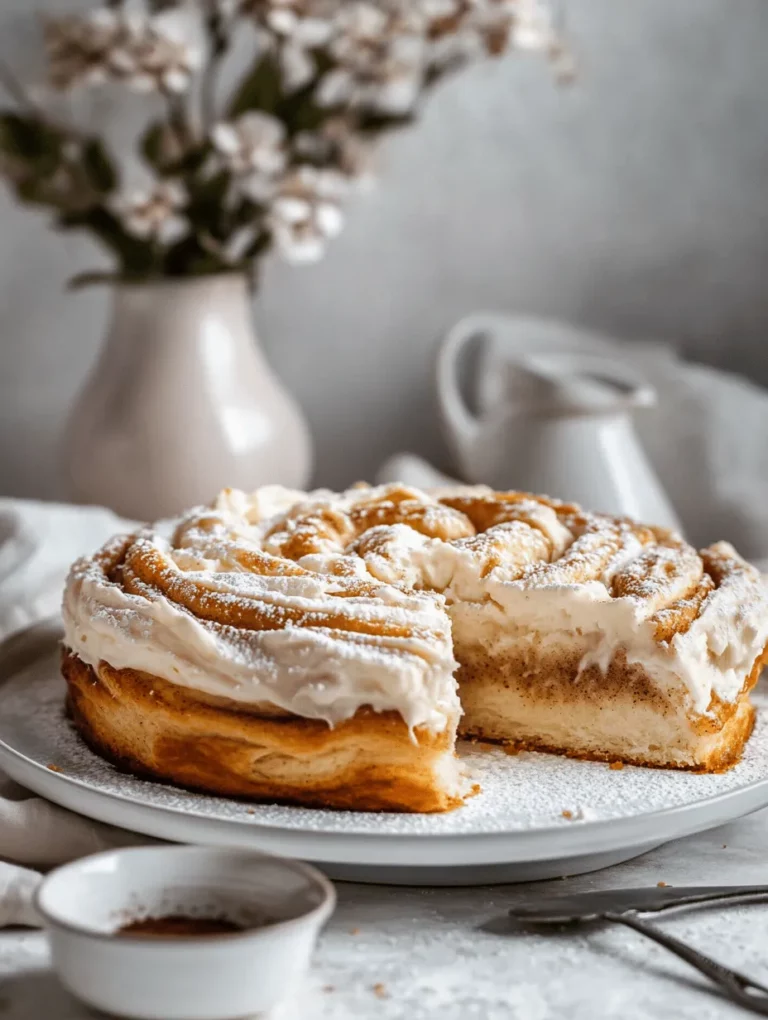Introduction
Cinnamon rolls have long been a beloved treat, cherished for their warm, sweet aroma and gooey, spiced filling. Whether enjoyed as a breakfast indulgence, a comforting snack, or a delightful dessert, these soft pastries evoke cozy memories of family gatherings and festive mornings. But for those of us with busy schedules, spending hours in the kitchen can feel overwhelming. That’s where this easy one-hour cinnamon rolls recipe comes into play. This quick and straightforward method promises delicious results in just one hour, making it perfect for novice bakers and seasoned chefs alike who crave a homemade delight without the wait.
Imagine pulling a tray of freshly baked cinnamon rolls from the oven, the sweet scent wafting through your home, and knowing that within an hour, you can enjoy a warm, gooey treat right from your kitchen. This recipe is designed to simplify the process, ensuring you can savor the joy of baking without compromising on flavor or texture.
Understanding Cinnamon Rolls
To appreciate the allure of cinnamon rolls, it’s worth exploring their historical background. Cinnamon rolls, or “cinnamon buns,” have roots that trace back to ancient times, with variations appearing in various cultures worldwide. In Sweden, for instance, the kanelbullar is a beloved pastry often enjoyed during “fika,” a traditional coffee break. Meanwhile, in the United States, cinnamon rolls have become a staple breakfast item, often served warm with a drizzle of icing.
These delightful rolls come in countless variations, from sticky buns topped with caramel to nut-studded versions bursting with flavor. Regardless of the style, the essence of a cinnamon roll lies in the harmonious balance of flavors: the sweetness of the dough, the buttery richness of the filling, and the warm spice of cinnamon. This trifecta creates an indulgent experience that is hard to resist, making cinnamon rolls a timeless favorite.
Ingredients Breakdown
Dough Ingredients
Now, let’s delve into the key ingredients that make up our easy one-hour cinnamon rolls, starting with the dough. Each component plays a crucial role in achieving that perfect fluffy texture and delightful flavor.
– All-Purpose Flour: This is the backbone of our dough. All-purpose flour strikes a perfect balance between protein content and gluten formation, ensuring that our cinnamon rolls are soft but have enough structure to hold their shape. When measuring flour, it’s essential to spoon it into the measuring cup and level it off for accuracy. Too much flour can lead to dense rolls.
– Granulated Sugar: Sugar not only sweetens the dough but also helps with browning during baking. It creates that lovely golden crust we all adore. The sugar also contributes to the overall flavor profile, making the rolls irresistible.
– Instant Yeast: The star of our quick recipe! Instant yeast allows the dough to rise rapidly, making it perfect for a one-hour cinnamon roll. Unlike active dry yeast, it doesn’t require proofing in water, so you can mix it directly into the dry ingredients. If you only have active dry yeast, you can still use it; just dissolve it in warm milk before adding it to the dough.
– Salt: Although it may seem counterintuitive to add salt to a sweet recipe, it enhances the overall flavor. Salt balances the sweetness and prevents the dough from becoming bland. It also strengthens the gluten structure, helping our rolls maintain their shape.
– Warm Milk: Warm milk is essential for yeast activation. The warmth helps the yeast to bloom, resulting in a light and airy dough. Be careful not to use boiling milk; instead, heat it gently until it’s warm to the touch.
– Unsalted Butter: Using unsalted butter allows you to control the salt content in your recipe, ensuring balanced flavors. Butter adds richness and tenderness to the dough, contributing to that melt-in-your-mouth texture we all love.
– Egg: An egg adds richness and structure to the dough. It also helps with the browning process, giving our cinnamon rolls that appealing golden hue. Make sure the egg is at room temperature for the best results.
Filling Ingredients
Next, let’s explore the components of the filling that make these cinnamon rolls so irresistible.
– Brown Sugar vs. White Sugar: For the filling, brown sugar is preferred for its rich flavor and moisture content, which helps keep the rolls soft. The molasses in brown sugar provides a deeper, more complex sweetness than granulated sugar. However, a mix of both sugars can also be used for a balanced flavor profile.
– Ground Cinnamon: This aromatic spice is the star of the filling. Not only does it provide that signature cinnamon flavor, but it also offers several health benefits, including anti-inflammatory properties and potential blood sugar regulation. Freshly ground cinnamon can elevate the flavor even further, but store-bought ground cinnamon works well for convenience.
– Softened Butter: This is essential for spreading the filling evenly over the dough. Ensuring the butter is soft, not melted, allows for easy spreading and helps the sugar and cinnamon adhere to the dough, creating that delightful swirl we crave in a perfect cinnamon roll.
Cream Cheese Frosting
No cinnamon roll is complete without a drizzle of frosting, and cream cheese frosting is the perfect complement to our rolls.
– Benefits of Cream Cheese: Cream cheese adds a tangy flavor that balances the sweetness of the rolls. It creates a luscious, creamy texture that melts into the warm rolls, enhancing each bite.
– Adjusting Sweetness: The sweetness of the frosting can be adjusted by varying the amount of powdered sugar. For a less sweet frosting, simply reduce the sugar to suit your taste.
– Role of Milk and Vanilla Extract: A splash of milk in the frosting ensures a smooth, pourable consistency. Vanilla extract adds depth and enhances the overall flavor of the frosting, making it irresistible.
Step-by-Step Instructions for Perfect Cinnamon Rolls
With our ingredients ready, it’s time to dive into the step-by-step instructions for making these delicious cinnamon rolls. Follow along closely to ensure success:
1. Prepare the Dough: In a large mixing bowl, combine the all-purpose flour, granulated sugar, instant yeast, and salt. Whisk together to ensure even distribution of the dry ingredients.
2. Incorporate Wet Ingredients: In a separate bowl or measuring cup, whisk together the warm milk, softened butter, and egg until well combined.
3. Mix the Dough: Pour the wet mixture into the dry ingredients. Stir with a wooden spoon or spatula until a shaggy dough begins to form. The dough will be sticky at this stage, which is expected.
4. Knead the Dough: Turn the dough out onto a floured surface and knead it for about 5-7 minutes until it becomes smooth and elastic. If the dough is too sticky, sprinkle in a little more flour, but be cautious not to add too much.
5. Let it Rise: Form the dough into a ball and place it in a lightly greased bowl, covering it with a clean kitchen towel. Let it rise in a warm place for about 20 minutes, or until it doubles in size. This quick rise is thanks to the instant yeast.
6. Prepare the Filling: While the dough rises, combine the brown sugar and ground cinnamon in a small bowl. Set aside.
7. Roll Out the Dough: Once the dough has risen, turn it out onto a lightly floured surface and use a rolling pin to roll it into a rectangle, approximately 12×18 inches in size. The goal is to create a thin layer that will be easy to roll up.
8. Spread the Filling: Softened butter should be spread evenly across the rolled-out dough, leaving a small border around the edges. Sprinkle the cinnamon-sugar mixture generously over the buttered surface, making sure it adheres well.
9. Roll Up the Dough: Starting from one long edge, carefully roll the dough tightly into a log, pinching the seam to seal. This step is crucial for creating those beautiful swirls.
10. Slice the Rolls: Using a sharp knife or dental floss, slice the rolled dough into 12 equal pieces. This will create the individual cinnamon rolls we’ll bake.
11. Arrange in a Baking Dish: Place the sliced rolls in a greased baking dish, leaving a little space between each one to allow for expansion during baking. Cover the dish with a kitchen towel and let the rolls rest for 15 minutes to rise slightly.
At this point, your kitchen will likely be filled with the intoxicating aroma of cinnamon, and you’ll be tantalizingly close to enjoying your freshly baked cinnamon rolls. Stay tuned for the final baking instructions and tips for achieving that perfect golden finish.

Mixing the Dough: Techniques for a Uniform Mix
To start your Easy One Hour Cinnamon Rolls, the first step is mixing the dough. This is crucial for achieving a uniform texture and ensuring that all ingredients are well integrated. Begin by combining warm milk, sugar, and yeast in a mixing bowl. Allow this mixture to sit for about 5 minutes until it becomes frothy, indicating that the yeast is active.
In another bowl, whisk together the flour and salt. Once the yeast mixture is ready, gradually add the flour mixture to the wet ingredients. Use a wooden spoon or spatula to mix until a shaggy dough forms. Avoid over-mixing at this stage; you want just enough incorporation to bring the dough together without developing too much gluten.
Kneading: Importance of Gluten Development
Kneading is a pivotal step in bread-making that helps develop gluten, which gives the dough its structure. Once your dough has come together, turn it out onto a lightly floured surface. Knead the dough for about 5 to 7 minutes, or until it is smooth and elastic. If the dough feels too sticky, sprinkle a bit of flour onto the surface and continue kneading.
The goal is to achieve a dough that is soft but not overly tacky. Proper kneading will create the necessary elasticity, allowing your cinnamon rolls to rise beautifully and hold their shape during baking.
Tips for Managing Sticky Dough
Working with sticky dough can be challenging, but there are several techniques to manage it effectively. First, always keep your hands and the work surface lightly floured. If the dough sticks to your fingers, a light dusting of flour will help.
Another useful tip is to use a bench scraper. This tool can help you lift and fold the dough without adding too much additional flour. If you find the dough is excessively sticky, consider letting it rest for a few minutes. This allows the flour to hydrate fully, which can make it easier to handle.
The First Rise: Understanding Fermentation and Its Effects on Texture
After kneading, place your dough in a lightly greased bowl and cover it with a clean kitchen towel or plastic wrap. This is the first rise, which typically lasts about 30 minutes. During this time, the yeast ferments the sugars in the dough, producing carbon dioxide that causes the dough to expand.
Fermentation is crucial as it not only helps the dough rise but also enhances flavor and texture. You’ll know the dough is ready when it has doubled in size and is puffy to the touch. Depending on the room temperature, this may take a bit longer, so be patient.
Preparing the Filling: Maximizing Flavor with Cinnamon and Sugar
While the dough is rising, prepare the filling. Combine brown sugar, ground cinnamon, and melted butter in a bowl. The ratio of cinnamon to sugar can be adjusted according to your taste preference; the more cinnamon you add, the stronger the flavor will be.
Mix these ingredients until well combined. This filling is what makes your cinnamon rolls decadent, so don’t hesitate to use high-quality cinnamon for the best flavor. Consider adding a pinch of nutmeg or even a splash of vanilla extract for an extra layer of deliciousness.
Rolling Out the Dough: Techniques for Achieving the Right Thickness
Once the dough has risen, turn it out onto a floured surface. Use a rolling pin to roll the dough into a rectangle approximately 1/4 inch thick. This thickness is crucial; too thin, and the rolls will be tough, too thick, and they won’t bake through properly.
To ensure an even roll, start from the center and roll outwards, rotating the dough as you go. If the dough resists rolling, let it rest for a few minutes to relax the gluten before continuing.
Adding the Filling: Ensuring Even Coverage for Optimal Taste
With your dough rolled out, it’s time to spread the filling. Use a spatula to evenly coat the surface with the melted butter first, followed by the cinnamon-sugar mixture. Make sure to cover the entire surface, leaving a small border (about 1/2 inch) around the edges. This will help seal the roll when you begin to roll it up.
Rolling the Dough: How to Achieve a Tight Roll
To roll the dough, start at one of the long edges and carefully lift it, tucking it over the filling. As you roll, keep the dough taut but not so tight that the filling squeezes out. Aim for a tight cylinder to help create those beautiful swirls that are characteristic of cinnamon rolls. Pinch the seam to seal it once you’ve rolled the dough up completely.
Cutting the Rolls: Tools and Techniques for Uniformity
Once you have your log, it’s time to cut it into rolls. Use a sharp knife or a piece of dental floss (unflavored) for a clean cut. This technique will prevent squashing the rolls, ensuring they maintain their shape. Slice the log into 12 equal pieces for standard-sized rolls. If you prefer monster-sized rolls, cut fewer pieces and adjust the baking time accordingly.
The Second Rise: Importance of This Step for Fluffiness
Place the cut rolls into a greased baking dish, spacing them out evenly. Cover them once again with a kitchen towel and allow them to rise for another 30 minutes. This second rise is essential for fluffiness; it allows the rolls to expand and become light and airy in the oven.
Preheating the Oven: Why Timing Matters
While the rolls are rising, preheat your oven to 375°F (190°C). Preheating is crucial because it ensures that your rolls will start baking immediately once placed in the oven, helping them rise further and develop a delicious crust.
Baking: Signs to Look For to Ensure Perfect Rolls
Once the rolls have risen, place them in the preheated oven. Bake for 20 to 25 minutes, or until the tops are golden brown and a skewer inserted in the center comes out clean. The aroma of cinnamon and sugar will fill your kitchen, making it hard to resist! Keep an eye on them during the last few minutes of baking to avoid over-browning.
Making the Cream Cheese Frosting
To elevate your cinnamon rolls, prepare a cream cheese frosting. In a mixing bowl, combine softened cream cheese, butter, powdered sugar, and vanilla extract. Beat the mixture with an electric mixer until smooth and creamy. If the frosting is too thick, add a splash of milk to achieve your desired consistency.
Flavor Adjustments and Tips for a Perfect Consistency
For a little twist, consider adding a teaspoon of lemon juice to the frosting for a refreshing tang that perfectly complements the sweetness of the rolls. If you prefer a richer flavor, you can also add a pinch of cinnamon to mirror the filling in the rolls.
Importance of Frosting the Rolls While Warm
Once the cinnamon rolls are out of the oven, it’s best to frost them while they are still warm. This allows the frosting to melt slightly into the rolls, creating a delicious, gooey topping. Spread the frosting generously over the top of each roll, letting it drizzle down the sides.
Serving Suggestions and Pairing Ideas
Cinnamon rolls are incredibly versatile and can be served in various settings. Pair them with a hot cup of coffee or tea for a delightful breakfast or brunch experience. For a more indulgent dessert, serve them with a scoop of vanilla ice cream or a dollop of whipped cream.
If you want to get creative, consider adding nuts such as pecans or walnuts to the filling or as a topping for added crunch. Dried fruits like raisins or cranberries also make excellent additions, providing bursts of sweetness alongside the cinnamon.
Storage and Reheating Best Practices
To store leftover cinnamon rolls, let them cool completely before placing them in an airtight container. They can be kept at room temperature for up to two days or in the refrigerator for up to a week.
When reheating, gently warm them in the microwave for about 10–15 seconds or place them in a preheated oven at 350°F (175°C) for about 5–10 minutes. This will help restore their original softness.
For long-term storage, you can freeze the rolls. Wrap each roll tightly in plastic wrap and then in aluminum foil, or place them in a freezer-safe container. They can be frozen for up to three months. When you’re ready to enjoy them, thaw at room temperature and reheat as mentioned.
Conclusion
Making cinnamon rolls at home is not just a baking project; it’s an experience that fills your kitchen with warmth and delightful aromas. The joy of pulling apart a warm, gooey cinnamon roll, topped with creamy frosting, is hard to beat.
This Easy One Hour Cinnamon Rolls recipe is perfect for both novice bakers and experienced ones looking for a quick treat. Don’t hesitate to experiment with variations, whether it’s adding your favorite nuts, changing up the spices, or adjusting the frosting flavors.
The satisfaction of creating a homemade treat that’s ready in just one hour is truly rewarding. So gather your ingredients, roll up your sleeves, and indulge in the delightful world of homemade cinnamon rolls!

